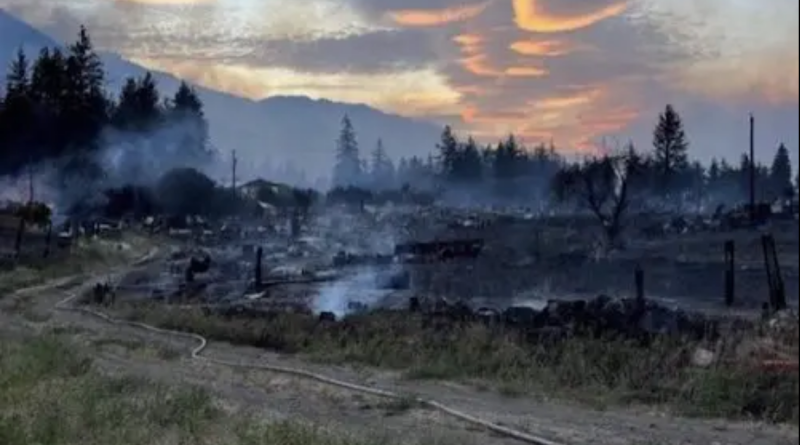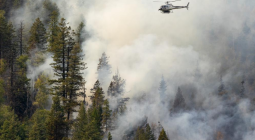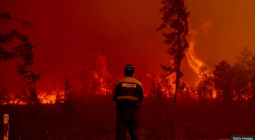Lytton, B.C. Rebuilds at ‘Glacial’ Pace While Wildfires Burn from Brazil to Arctic

This story includes details on the impacts of climate change that may be difficult for some readers. If you are feeling overwhelmed by this crisis situation here is a list of resources on how to cope with fears and feelings about the scope and pace of the climate crisis.
As wildfires rage in multiple hot spots around the world, the town Lytton, British Columbia, is still waiting, three years and C$239 million in recovery money later, to rise from its ashes.
It has been slow, expensive, and hurt-filled going for the residents of Lytton and Lytton First Nation since their homes were incinerated in a wildfire that roared into their lives on June 30, 2021, reports CBC News.
Fifteen minutes was all it took for flames to completely engulf a searingly hot Lytton that day. Two seniors died, and more than a thousand were sent fleeing with only the clothes on their backs.
Only a “handful of people” have since returned to an area that was once home to roughly 2,500, writes CBC, with only five homes nearing completion and roughly 15 building permits now approved. That progress has been so slow, “despite more than $239 million in provincial and federal funding committed to help rebuild,” is a source of bewilderment, and anger, for many of those still waiting to return.
Lytton First Nation received more than $120 million in recovery funding, plus an additional $1.3 million to fast-track 20 homes and help build 175 more using the federal Housing Accelerator Fund, a spokesperson for the Minister of Indigenous Services Patty Hajdu told CBC.
As for where more than $41 million in provincial recovery dollars went,B.C. Auditor General Michael Pickup is investigating. His report is expected early next year.
Some dollars have been accounted for. In 2023, Lytton paid out more than $12 million for excavation and debris cleanup, plus another $300,000 to project managers.
‘Bones of Our Ancestors’
The glacial pace of recovery owes in part to the fact that Lytton and the surrounding territory constitute “one of the oldest continuously inhabited settlements in North America,” with Lytton itself built atop burial grounds.
“We knew that we were walking on the bones of our ancestors. Lytton is a storied place,” Lytton First Nation historian John Haugen told CBC.
When artifacts began to emerge from the burned soil, all efforts at remediation had to cease, under the requirements of the provincial Heritage Conservation Act, until the site in question had been assessed.
That requirement is generating friction between First Nations and non-Indigenous community members. Reserve lands are exempt from archaeological fees, which are proving considerable.
Lytton has so far paid $1.6 million to AEW, a company with links to the Nlaka’pamux Nation Tribal Council, and more than $1 million to Teranis Consulting Ltd., which “specializes in providing First Nations with environmental consulting services related to contaminated land investigation and remediation,” CBC writes.
People living off-reserve, however, “have received estimates or invoices for thousands of dollars for archaeological monitoring or work” that is not covered by insurance, CBC says.
“If the B.C. government thinks it’s that important to do this scale of archaeology work after a disaster then they should foot that bill for that entire amount,” Ken Pite, who lost his retirement home in the fire, told CBC.
Generating further tension is the existence of a federal grant program that is only available to homeowners who rebuild to net-zero and fire-resilient standards. The program requires trained contractors who are thin on the ground in Lytton and charge steep fees.
A final footnote to the story of a community still waiting for its future to arrive: a much-lauded initiative between the Southern Alberta Institute of Technology (SAIT) and the Kanaka Bar Indian Band that would have seen Lytton “built back better” with homes constructed from state-of-the-art fireproof materials has been shelved.
Lytton Waits While Other Regions Burn
Across large swathes of California, Brazil, and the northern regions of Canada and Russia, wildfires are raging, incubated by intense heat and engrained drought.
The blazes are endangering all things in their immediate path and adding ever more atmospheric fuel to drive global heating.
In the latest news, the Washington Post reports a new fire has broken out in California, even as the rampaging Thompson blaze, which led to the evacuation of nearly 30,000 people last week, was reported contained. The latter happened thanks to the efforts of more than 1,400 fire personnel who had to contend with strong, gusting winds, and daytime temperatures in excess of 40°C.
Tropical Wetland On Fire
Meanwhile, wildfires continue to ravage Brazil’s Pantanal, one of world’s largest tropical wetlands, located south of the Amazon.
“Home to millions of caimans, parrots, giant otters, and the world’s highest density of jaguars,” the Pantanal has seen 3,538 wildfires break out since 2024 began, “an increase of more than 2,000% as compared with last year,” reports France24. “In June alone, 2,639 fires were detected—six times the highest number ever recorded.”
The rash of fires in the Pantanal is a tragic subset of a larger pattern unfolding across the Brazilian Amazon. According to latest data from Brazil’s National Institute for Space Research (INPE), the region “recorded 13,489 wildfires in the first half of the year, the worst figure in 20 years.” Experts say the spike in fires—“up more than 61% compared to the same period last year,” notes France24—owes to the historic drought the Amazon has faced since last year.
“The environment is drier, and thus vegetation is more dried out and more vulnerable to fires,” Brazil Greenpeace spokesperson Romulo Batista told France 24. He added that the majority of the current fires were likely caused by agricultural burning, not wildcard factors like lightning strikes
The latest INPE data is grim news for Brazil’s government, “with the number of fires increasing even as deforestation in the Amazon—which helps reduce global warming by absorbing carbon dioxide—is on the wane,” the news story states. Forest loss has “decreased 42% from January 1 to June 21, as compared with the same period in 2023.”
But the rainforest is not the only part of Brazil that is burning. Spanning a territory equal to France, Germany, Italy, Spain and the UK combined, the Cerrado, “one of Earth’s three great savannas, along with Africa’s and Australia’s, experienced 13,229 fires from January through June, almost as many as the Amazon.”
Arctic Aflame
Wildfires are also raging across the northern reaches of the planet, from Fort Nelson, British Columbia to Russia’s Sakha Republic.
The Patry Fire, currently burning some 22 kilometres from Fort Nelson (pop. 3,400), first ignited last July, slumbering through the winter as a so-called “zombie fire”. Now fully awake, reports CTV, it is currently more than 700 kilometres square and growing, after switching virtually overnight from being designated “held” to “out of control”.
The Arctic Ocean-bordering Sakha Republic is likewise ablaze in Russia’s far east corner, with the three-million-square-kilometre region accounting for 72 of the 164 wildfires recorded in the Arctic Circle through June 24, states a release from the European Union’s Copernicus Atmosphere Monitoring Service (CAMS).
The vast swathes of northern boreal forest and tundra now ablaze bode very ill for the global climate. The latest data collection effort by CAMS showed carbon emissions over the Arctic region t the third-highest level for June since 2003.
The connection between wildfires and carbon emissions is confirmed by a new analysis of the atmospheric impact of Canada’s 2023 wildfires conducted by researchers from the World Resource Institute’s (WRI) Global Forest Watch Initiative and the University of Maryland. Roughly 7.8 million hectares of forests burned in Canada last year, “more than six times the annual average since 2001,” the research team writes in the journal Global Change Biology.
Those fires produced “roughly three billion tons of carbon dioxide—nearly four times the carbon emissions of the global aviation sector in 2022, and 25% more than from all tropical primary forest loss combined in 2023.”
CAMS also warns of the potential for a dangerous feedback loop if the Arctic fires lead to extensive deposition of black carbon and soot. Such deposition “can potentially darken snow and ice surfaces, reducing their albedo and causing them to absorb more solar energy, making them more prone to melting,” the agency states.






